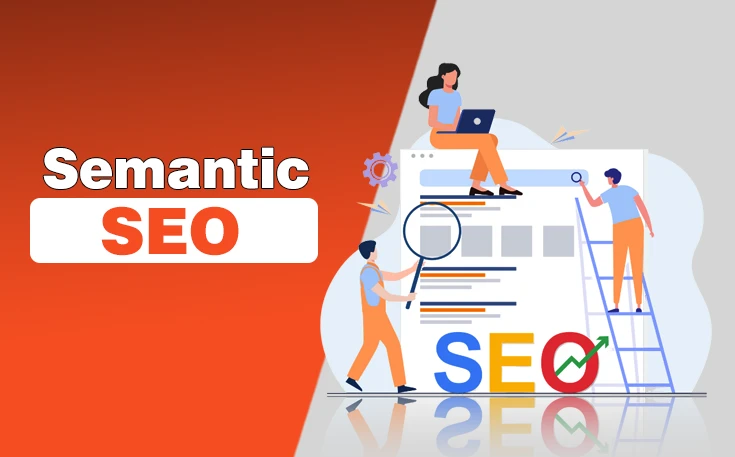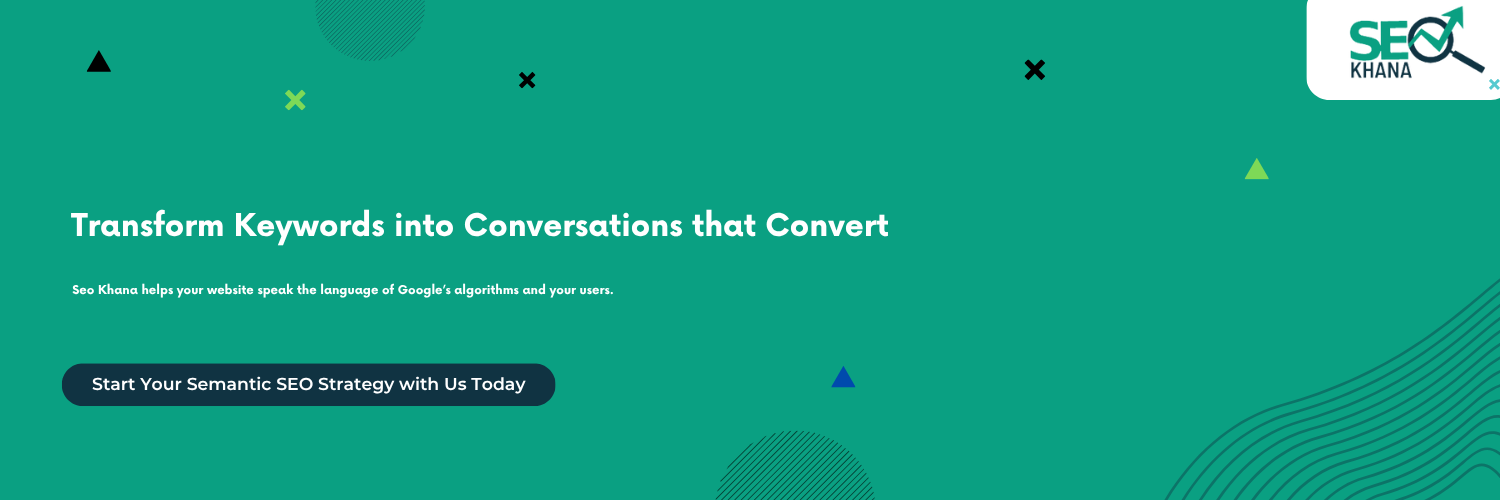In today’s rapidly evolving digital world, ranking on search engines isn’t just about using the right keywords — it’s about understanding why people search and what they truly want to find. This is where a smarter, more intuitive approach to content optimization comes into play, focusing on meaning, context, and user intent rather than just keyword stuffing.
At Seo Khana, we don’t just follow SEO trends we lead them. As a full-service SEO agency, we specialize in implementing cutting-edge strategies like Semantic SEO to help your content speak the language of both users and search engines. Whether you’re aiming to improve organic visibility, increase traffic, or secure featured snippets, this future-proof foundation is exactly what your website needs and Seo Khana is here to build it for you.
In this article, we’ll explore what Semantic SEO really means, why it matters more than ever, and how to implement it effectively — with practical examples and proven techniques we use every day with our clients.
What Is Semantic SEO?
Semantic SEO is an advanced optimization approach that prioritizes understanding the meaning behind search queries instead of focusing solely on keywords. Instead of targeting generic terms like “best laptop,” this strategy seeks to grasp and address the deeper intent behind questions such as “What is the best laptop for remote work in 2025?” or “Which laptops are ideal for video editing under $1000?” At its essence, it’s about grasping context, user intent, and the relationships between related concepts. This method goes beyond simple keyword matching to ensure bset evergreen content truly reflects how people think, speak, and search naturally.
Understanding the Deeper Meaning
Traditional SEO focuses on keywords as isolated terms, which can result in content that feels shallow, repetitive, or disconnected from what users truly want. Modern search engines, leveraging technologies like Natural Language Processing (NLP), Google’s Knowledge Graph, and the BERT algorithm, aim to understand the relationships between words and the broader context of topics.
For example:
- When someone searches for “apple,” they could be referring to the fruit or the technology company.
- A well-optimized page provides clear context through surrounding content, helping search engines accurately interpret the intended meaning.
This deeper understanding is essential in today’s AI-driven search environment. At Seo Khana, we create content that speaks both to users and search engines, ensuring your website addresses the real questions your audience has and is fully recognized for it.
Why Semantic SEO Matters
In today’s digital landscape, search engines are no longer just text matchers — they are intelligent systems built to understand human language, intent, and context. This transformation means that traditional SEO strategies, which rely heavily on keyword repetition and exact matches, are no longer enough to stay competitive. This is exactly where Semantic SEO becomes essential.
1. It Aligns with How Search Engines Evolve
Modern search engines like Google use advanced algorithms such as BERT and MUM to understand why users search for something, not just what they type. These models evaluate sentence structure, semantics, and user behavior to deliver more relevant and personalized results. Semantic SEO ensures your content is structured and written in a way that speaks the same language as these intelligent systems.
At Seo Khana, we optimize content not just for visibility but for relevance and accuracy, helping clients rank for complex, intent-driven queries.
2. It Expands Your Reach Across Related Queries
By focusing on the broader topic and the relationships between ideas, semantic SEO allows your content to rank for more variations of a search including long-tail keywords, questions, and voice searches. A single well-structured page can appear in results for dozens (or even hundreds) of related queries.
For example, a blog post about “healthy breakfast recipes” optimized semantically might also rank for “quick morning meals,” “best breakfasts for weight loss,” and “what to eat before work.”
3. It Enhances User Experience (UX)
Semantic SEO encourages you to create content that is comprehensive, meaningful, and easy to navigate. Instead of thin articles built around one keyword, you develop rich, useful resources that address multiple angles of a topic something both users and search engines appreciate.
4. It Increases the Chances of Rich Snippets and Voice Search Visibility
When your content is semantically structured and enhanced with markup, it becomes more eligible for rich features like:
- Featured snippets
- People Also Ask boxes
- Knowledge panels
- Voice search results
These elements significantly boost your visibility and click-through rates — and they’re often the difference between showing up on the page and standing out on the page.
The SEO content optimization is no longer just about keywords — it’s about intent, structure, and meaning. At SEO Khana, we future-proof your content strategy using Semantic SEO principles. From contextual relevance to intelligent planning, we ensure every piece of content is optimized for how search engines understand and how real users engage.
Semantic SEO vs Traditional SEO
While both Semantic SEO and traditional SEO share the goal of improving search visibility, the strategies behind each are fundamentally different. Understanding these differences is critical for building a content strategy that truly aligns with how users search and how search engines interpret.
Traditional SEO: Keyword-Centric Optimization
Traditional SEO focuses heavily on:
- Targeting exact-match keywords
- Keyword density
- Basic on-page elements like title tags and meta descriptions
- Ranking for a single phrase or variation
While this approach worked well in the early days of SEO, it often leads to:
- Over-optimized, unnatural content
- Missed ranking opportunities for related or long-tail queries
- Shallow user experience focused on machines, not people
Semantic SEO: Meaning-Driven Strategy
Semantic SEO, on the other hand, shifts the focus from “What are people typing?” to “What are people really looking for?” It leverages:
- Topic clusters and entity relationships
- Search intent and context
- Synonyms, related phrases, and long-form content
- Natural Language Processing (NLP) and semantic search principles
This leads to:
- Broader ranking coverage
- Higher engagement and lower bounce rates
- Content that aligns with Google’s modern algorithm updates
For example, a traditional SEO article might focus only on “best running shoes,” while a semantic SEO article will also answer:
- “What makes a good running shoe?”
- “Best running shoes for flat feet”
- “How to choose running shoes for beginners”
Why Seo Khana Uses Semantic SEO
At Seo Khana, we focus on creating content strategies that evolve alongside search engines rather than opposing them. Our services are crafted to:
- Cover comprehensive topics instead of just isolated keywords
- Align content with user intent throughout the entire journey
- Utilize structured data and semantic markup to improve indexing
- Establish topical authority and sustainable ranking power
Whether you manage a blog, an e-commerce seo, or a corporate website, adopting this approach guarantees your content remains relevant, easy to find, and built for lasting performance.
How to Practice Semantic SEO
Implementing Semantic SEO involves more than just adding keywords — it’s about building content ecosystems that reflect the true meaning behind what users are searching for. At Seo Khana, we apply a strategic, research-driven process that ensures content is not only optimized, but deeply aligned with how search engines and users interpret meaning.
1. Understand User Intent
Before writing any content, you must understand the intent behind the query. Is the user looking for information, a product, a comparison, or a how-to guide?
✅ Tip: Use tools like Google’s “People Also Ask,” AnswerThePublic, and keyword intent analyzers to map out different user intents around a topic.
Example: For the keyword “coffee grinder,” semantic intent may include “how to use a coffee grinder,” “best grinders for espresso,” or “manual vs electric grinder.”
2. Build Comprehensive Topic Clusters
Instead of creating single, isolated pages for every keyword, build topic clusters a main pillar page supported by several in-depth subtopics.
✅ This helps search engines understand the relationship between your content and boosts your topical authority.
Seo Khana’s content strategy experts design internal linking structures and pillar-subpage systems that reinforce semantic relationships.
3. Use Semantically Related Terms
Go beyond exact keywords. Incorporate:
- Synonyms and variations
- Entity-based terms (brands, places, tools)
- Contextual phrases that match user expectations
✅ Tools like Clearscope, MarketMuse, or semantic SEO automation platforms can help you identify these terms easily.
4. Implement Structured Data & Semantic Markup
Structured data helps search engines “understand” your content better.
✅ Use semantic SEO markup (via Schema.org) to define content types such as:
- Articles
- FAQs
- Products
- Reviews
- How-to guides
On WordPress? Seo Khana integrates semantic SEO WordPress plugins like RankMath and Yoast with customized schema enhancements for better SERP features.
5. Optimize for Natural Language & Long-Tail Queries
Write in a conversational, question-driven style. Incorporate long-tail keywords, FAQs, and question-answer formats that reflect how users search.
✅ Example:
Instead of writing “laptop deals 2025,” consider:
- “What are the best laptops for students in 2025?”
- “Top affordable laptops for remote work this year”
This increases the chance of ranking for voice search and featured snippets two major outcomes of strong semantic SEO.
6. Create Internal Links with Meaning
Internal linking is not just for SEO it’s also part of semantic structure. Link related articles together based on topic, not just random anchor text.
✅ Seo Khana’s internal linking audits ensure that every link serves a semantic purpose and supports the overall topic architecture.
Semantic SEO in WordPress
WordPress is a popular platform that supports semantic SEO effectively through its flexible tools and plugins. At Seo Khana, we help optimize WordPress sites to improve search engine understanding and user experience.
- Use SEO Plugins: Tools like Yoast SEO and Rank Math add structured data (schema) to your content, helping search engines better interpret your pages.
- Semantic Content Structure: Proper use of headings (H1, H2, etc.) and HTML5 tags organizes content clearly for both users and search engines.
- Topic Clusters & Internal Linking: Group related posts into categories and link them strategically to build topical authority.
- FAQ & Voice Search: Adding FAQ schema increases chances of featured snippets and voice search visibility.
- AI Tools Integration: Seo Khana uses AI tools to find related terms and optimize content semantically.
With these techniques, your WordPress site becomes more visible, relevant, and user-friendly.
learn more about:
Step-by-Step Semantic SEO Guide
Implementing Semantic SEO may sound complex, but with a structured approach, it becomes a clear and repeatable process. Whether you’re starting from scratch or optimizing existing content, this step-by-step guide will help you create content that aligns with how users think and how search engines understand.
At Seo Khana, this is the exact methodology we use to deliver high-ranking, intent-driven content for our clients.
✅ Step 1: Identify Core Topics and User Intent
Start by selecting a broad topic related to your niche. Then break it down into intent-based queries using tools like:
- Google’s “People Also Ask”
- AnswerThePublic
- Semrush or Ahrefs Keyword Explorer
Goal: Understand what users are really trying to find — informational, navigational, transactional, or comparative content.
✅ Step 2: Create a Topic Cluster
Develop a pillar page that covers the core topic in-depth, and then link to multiple supporting subpages that cover related subtopics.
Example: A pillar page on “Organic Skincare” could link to:
- “Best Organic Ingredients for Sensitive Skin”
- “How to Read Organic Skincare Labels”
- “DIY Organic Face Mask Recipes”
Seo Khana Tip: We build internal linking strategies that reinforce topical relevance and improve crawlability.
✅ Step 3: Use Semantically Related Keywords
Don’t just use your main keyword include:
- Synonyms (e.g. “eco-friendly,” “natural”)
- Related phrases (e.g. “paraben-free,” “plant-based”)
- Common questions and modifiers
Use tools like Frase, Surfer SEO, or Google NLP API to find and structure these terms naturally.
✅ Step 4: Add Semantic SEO Markup
Use structured data (schema.org) to provide context to your content. Common types include:
- Article
- FAQ
- Product
- Review
- HowTo
Seo Khana uses custom schema implementations for each page type to maximize eligibility for rich results.
✅ Step 5: Optimize for UX & Natural Language
Use clear, conversational language that mimics how people speak — especially useful for voice search. Break up content into:
- Short paragraphs
- Bullet points
- Headings (H2, H3)
- Answer-focused sections
Bonus: Include FAQs and summaries that directly respond to intent-based queries.
✅ Step 6: Build Internal Links Strategically
Link related articles and pages using descriptive anchor text that helps Google understand content relationships.
Don’t link randomly every link should serve a semantic purpose.
✅ Step 7: Monitor and Improve Using Data
After publishing, track performance using:
- Google Search Console
- Google Analytics
- Rank-tracking tools
Monitor:
- Search queries you rank for
- Click-through rate
- Bounce rate
- Keyword variations appearing
Seo Khana continuously audits performance and adjusts semantic elements based on user behavior and evolving trends.
Conclusion:
This approach is transforming how websites engage with search engines and users by emphasizing meaning, context, and intent rather than just keywords. By adopting these advanced strategies, businesses can create richer, more relevant content that not only improves rankings but also delivers genuine value to their audience.
At Seo Khana, we specialize in providing tailored solutions—from content planning and semantic markup to automation and WordPress optimization—ensuring your website stays ahead in the ever-evolving digital landscape.
Partner with Seo Khana today and watch your online presence become smarter, stronger, and more successful.







